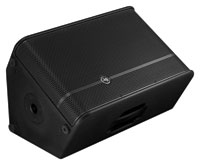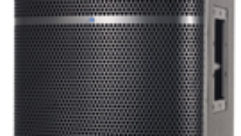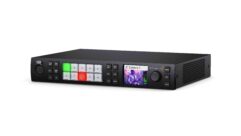

Mackie HD1221
Mar 4, 2011 10:48 AM,
by John McJunkin
Small speakers for small and large applications.
Mackie HD1221
The initial goals of the developers of small-form self-powered speakers were to make the speakers small and lightweight so they would be portable, to integrate amplifiers to reduce the complexity for inexperienced users like musicians and disc jockeys, and to make them sound halfway decent. They largely accomplished all of these goals, and small self-powered speakers became very popular. Over the years, the developers have made the speakers lighter and even more portable. They’ve also made them more sophisticated, integrating mixers and basic signal processing. Another phenomenon is the arrival of small self-powered speakers that deliver incredible audio quality. In the early days of self-powered speakers, the quality was a bit compromised in order to accomplish the developers’ other goals, but audio quality is important enough that it has become a key focus now, years down the road. Mackie has introduced its HD speaker series, including the 1221, which is a self-powered pole-mounted speaker with a 12in. LF driver and horn HF driver. I spent some time with a pair and discovered that although lightweight construction was not a key goal, high-quality audio was, and Mackie has accomplished it.
The speaker’s roughly trapezoidal cabinet is constructed of 15mm Baltic birch, making it hefty and very solid. In addition to its primary intended duty as a pole-mounted front-of-house speaker, the angle of the trapezoid is 60 degrees, deliberately intended for use as a floor-wedge monitor. The cabinet sports rounded corners and a texturized black paint finish. There are recessed carry slots on the sides and back, along with a rubberized recessed carry handle on the top of the speaker (top in the floor-wedge orientation). The cabinet features 12 1.5mm M10 flypoints, facilitating the flying of the speaker in many potential orientations. The rear panel of the speaker is dominated by the amplifiers’ large heat sink. Above that are an XLR input and loop output, an input level control, signal limiting and thermal indicator LEDs, a pushbutton switch to toggle the front-panel power light on and off, and a slider switch to determine the speaker’s voicing mode (contour, normal, or monitor). Below the heat sink is the IEC AC power inlet and main power switch. A substantial black powdercoated galvanized steel grille wraps around the front of the speaker to provide protection for the drivers.
The speaker’s drivers were both developed by EAW, which was acquired by Mackie’s parent company, Loud Technologies. This demonstrates pretty clearly that Mackie wanted to develop a higher-quality speaker than its previous offerings, considering the excellent reputation enjoyed by EAW in the world of high-end loudspeakers. The LF driver is 12in. in diameter and features a 3in. voice coil, a paper cone, and a neodymium magnet. The HF driver features a 1.75in. voice coil and a horn entry throat diameter of 1in. Its diaphragm is formed of heat-treated titanium and its magnet is made of ferrite. The HF driver’s horn was developed by Martin Audio, and its 90-by-50 degree dispersion pattern can be rotated as necessary by the user to gain more control over the speaker’s directionality.
The topology of the speaker’s internal amplifiers is Class D “Fast Recovery,” with the intent of providing quality amplification while reducing weight. The LF amplifier delivers 500W RMS, 1000W peak, with THD at less than 0.03 percent. The HF amplifier delivers 100W RMS, 200W peak, with THD also at less than 0.03 percent. The crossover point between the two drivers is at 1.5kHz. Mackie’s proprietary High-Definition Audio Processing is employed to time-align the two drivers and provide phase correction in order to increase intelligibility and overall fidelity. The voicing mode switch on the speaker’s rear panel facilitates basic equalization of the speaker: The contour mode provides both LF and HF boost, the normal mode is nominally flat, and the monitor mode engages a 100Hz HPF and broad cut at 3kHz.
The Mackie HD1221 speaker is pretty heavy, which is a negative in the domain of portable speakers. That being said, the reasons for the extra weight contribute strongly to the quality of the speaker, both in terms of physical construction and audio fidelity. The tradeoff in this case is quality versus portability. And yes, there are lighter, more portable powered speakers available, but the question is whether those speakers deliver as high audio quality—and I would respectfully submit that the answer is no. My point here is that if you need portable speakers, but your clients require higher-audio quality than is normally delivered by small self-powered speakers, the Mackie HD1221 steps into the breach to meet the requirements. I should also make it clear that when I say these speakers are heavy, the actual weight is 50lbs.—compared with competitors’ speakers in the mid 30lb. range. This is not a deal-breaker by any stretch. And I would also say that the increase in quality that accompanies the increase in weight is worthwhile.
Mackie HD1221
Mar 4, 2011 10:48 AM,
by John McJunkin
Small speakers for small and large applications.
The HD1221 sounds good—very good. And as a very frequent user of small self-powered speakers from a variety of manufacturers, I have heard the gamut in terms of quality, from very poor to excellent. In the spectrum, these rank way up in the excellent domain. The LF driver/amp combination is very powerful in the range it’s claimed to cover. The addition of a 15in. or 18in. subwoofer would be nice to round out the sub-65Hz domain, but from 65Hz on up, the bass is full, round, powerful, and tight. Similarly, the HF driver/amp combination delivers the goods from 1.5kHz north. The mids are not as honky as other speakers with horns that I’ve heard, largely due to the design of both the transducer and the horn. Mackie’s complex time-alignment and phase-coherency circuitry figures prominently here as well. The transition through the crossover is smooth and natural, and getting above 2kHz, the highs are smooth and not the least bit brittle or harsh. There are some bumps and dips in the frequency response, but generally it is pretty flat across the board (with the obvious exceptions of the voicing settings). The primary point I would make here is that these speakers deliver substantial SPL, but they do so with surprisingly little distortion at higher SPLs. They’re not quite studio-monitor quality, but they get a lot closer to that than most other small self-powered PA speakers.
Bottom line: Mackie enters the high-quality small self-powered speaker domain with a splash. The HD1221 delivers excellent quality audio with a small sacrifice in terms of weight. For any application that requires high-quality small speakers that can be flown or pole-mounted, these should be very high on the short list.
John McJunkin is the principal of Avalon Podcasting in
Chandler, Ariz. He has consulted in the development
of studios and installations and provides high-quality
podcast production services.
Product Summary
- Company: Mackie
www.mackie.com - Product: HD1221 Speakers
- Pros: High quality construction, excellent sound quality.
- Cons: Not lightweight in any sense.
- Applications: Small-to-midsize club/band PA, house of worship, DJs, AV rental.
- Price: $999
Product Specifications
- Frequency response (–10dB): 55Hz – 20kHz
- Frequency response (–3dB): 65Hz – 18kHz
- Horizontal coverage (–6dB): 90 degrees averaged 2kHz to 10kHz
- Vertical coverage (–6dB): 50 degrees averaged 2kHz to 10kHz
- Max peak SPL (calculated): 133dB
- Max peak SPL (measured): 124dB
- Crossover point: 1.5kHz
- Height: 24in./610mm
- Width: 15.2in./386mm
- Depth: 15in. /381mm
- Monitor position depth: 16.2in./412mm
- Weight: 50lb./22.7kg
- Input impedance: 11kΩ
Low-frequency Power Amplifier
- Rated power: 500W RMS 1000W peak
- Rated THD: < 0.03%
High-frequency Power Amplifier
- Rated power: 100W RMS 200W peak
- Rated THD: < 0.03%










